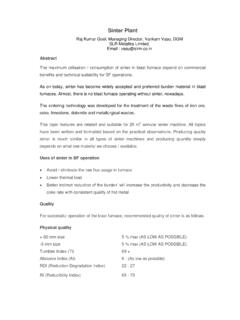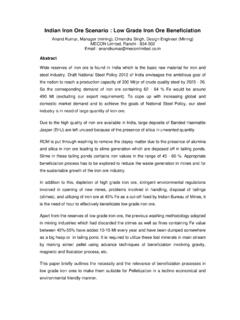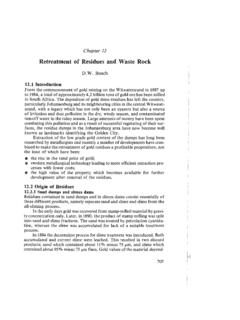Transcription of Utilization of Solid Waste from Steel Melting Shop
1 Utilization of Solid Waste from Steel Melting Shop D. K. Ambasta, Bikas Pandey, Nabarun Saha MECON Limited, Ranchi -834002, India Email : Abstract In Steel Industry, the production of Steel is associated with the generation of Solid Waste materials like slag, dust, sludge, etc. Significant quantities of wastes are generated from steelmaking process which is a focus point now-a-days its Utilization as well as environmental impact. Steelmaking process broadly includes all operations from primary and secondary steelmaking to ingot and continuous casting of Steel .
2 At each of these stages of steelmaking process, substantial amounts of wastes are generated. Thus minimization and Utilization of Waste through integrated Waste management has gained special significance in the present scenario, as these wastes have a wide ranging impact on the environment. The Solid Waste generation, presently in Indian Steel industry is in the range of 450 - 550 kg/t of crude Steel and recycling rate varies between 40 - 70 % which lead to higher production costs, lower productivity and further environmental degradation. It is very essential not only for recycling of the valuable metals and mineral resources but also to protect the environment.
3 In advance countries, the Solid Waste generation has been brought down below 200 kg/tls and the recycling and reuse rates are above 90% approaching almost to 100% level. This paper summarizes and analyzes the generation, composition, characteristics and present status of the Utilization of the most of the wastes generated from the steelmaking processes. The aim of the paper is to explore the various developments for total recycling of Solid Waste generated from Steel industry, so that the vision for making clean & green Steel with zero Waste can be achieved for survival and growth of Steel business in future.
4 Introduction The production of Steel in an integrated Steel plant involves several operations starting from use of natural raw materials, like iron ore, coal and flux in production of hot metal and further processing of hot metal into Steel and subsequently, rolling of Steel into finished products in the rolling mills. Quantities of Solid wastes generated in Steel melt shops are a cause for concern as their nature is quite variable and diversified. The Waste materials like slag, dust, sludge, etc. have a wide range of impact on the environment.
5 Earlier these wastes were either dumped or thrown out in the open space but now with rising concern for the environment and lack of space for the dumping of such huge wastes, new technologies are being explored to tackle these wastes as they contain concealed resources. Over the years, due to technological improvement in steelmaking and strict environmental regulations, emphasis on raw material quality and new markets coupled with innovative ideas on Waste reduction and rescue have resulted in drastic reduction in the quantity of Waste generated in Steel works from 1,200 kg to less than 200 kg per tonne of crude Steel and recycling rates have reached to 95 - 97 % in some parts of the world.
6 Few Steel industries have approached to cent percent Waste Utilization without discharge of any Waste to environment. In India, as per the draft National Steel Policy, 2012 / 2015, the crude Steel production is planned to be increased from present 100 Mt/yr to 300 Mt/yr and therefore, the Waste management system needs to be further strengthened for making successful and economically viable efforts for 100 % Utilization of all wastes. The progress on technological aspects, process options for enrichment of input materials and Solid Waste management in Indian Steel industry are moving at much slower pace than desired.
7 In order to sustain the present competitive market and for further growth in future, it is essential to use technological innovations and putting R & D efforts in order to reduce Waste generation and further for its recycling to Steel plants. Modern trend Steel industries are focusing on eco-friendly technologies for making clean & green Steel with zero Waste to environment to make Steel business a sustainable and successful venture. Types of wastes generation in Steel plant complex In Steel industry all three types of Waste materials are generated, , Solid , liquid & gaseous wastes.
8 The generation quantity of various types of Waste materials differ from one Steel plant to other depending upon the steelmaking processes adopted and pollution control equipments installed. The most common type of wastes generated in Steel plant are as follows. Solid wastes like, hot metal pretreatment slag, dust, GCP sludge, mill scale, refractories, scrap, muck & debris, etc. Liquid wastes like industrial effluent, oil, grease, etc. Gaseous wastes like flue gases, fume extraction, etc. However, Waste disposal and dump are very big issue for environment today and therefore, these wastes are being tried for reuse through recycling & Utilization .
9 These wastes are being used and recycled by various means but complete Utilization of these Waste are still challenges for industries, at present, in Steel industry, various efforts and experiments are being carried out in order to make use of 100 % wastes products without disposal of any type of wastes into the environment. Major advantages of recycling and Utilization of wastes are as follows. Economic advantages Saving of raw materials Conservation of resources Better & cleaner environment Reduced cost of disposal Conservation of energy Strengthen laws by the Government Community relation/Public image etc.
10 Solid Waste generation in Steel industry The technological developments for Solid Waste management in Indian iron and Steel industry is at advanced stage but moving at much slower pace than desired. Generally, for integrated Steel plant, each ton of liquid Steel needs about tonnes of raw materials, tonnes of water and 5 tonnes of air. The outcome from iron and steelmaking process is 8 tons of moist dust laden gases, ton of effluent water, to ton of Solid Waste , besides one ton of liquid Steel . In the first five decades of post independence era, till t h e year 2000, about 90 million tons of Solid Waste was estimated to accumulate.





